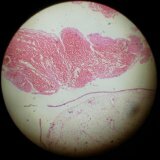Bubble skidding: clinic, diagnosis, treatment
 Some women after conception sometimes on their underwear notice the traces of blood. However, when a similar situation is detected, not all doctors turn to the doctor. At first glance it may seem that this situation poses no threat, but in some cases they can signal more serious diseases. And a bladder skid, a clinic, a diagnosis, the treatment of which is described below, is one of the diseases.
Some women after conception sometimes on their underwear notice the traces of blood. However, when a similar situation is detected, not all doctors turn to the doctor. At first glance it may seem that this situation poses no threat, but in some cases they can signal more serious diseases. And a bladder skid, a clinic, a diagnosis, the treatment of which is described below, is one of the diseases.
A blistering skid is a disease associated with trophoblast pathology. The trophoblast is a temporary organ that is necessary in order to attach a fetus to the wall of the uterus. From this, the placenta is subsequently formed.
Trophoblast is a tissue that begins to differentiate in the early stages of embryo formation. With the formation of the placenta, this tissue degenerates into extraembryonic tissue, which forms the fetal part of the septum necessary to separate the mother and embryo organisms and provide the intrauterine nutrition of the embryo.
To trophoblastic diseases are both tumors and conditions that predispose to the appearance of tumors. Such tumors are unique and rare. They are unique in that they develop from conception products, and then begin to germinate in the uterine cavity of the mother. Since these diseases occur against the background of pregnancy, they are usually affected by women of a young age.
The trophoblast is modified by a bubble drift into a number of small vesicles that "grab" the entire uterine cavity, have the ability to grow rapidly and spread into the lungs, that is, tend to metastasize.
Due to the chorionic gonadotropin, cells of the bladder drift are produced.
Chorionic gonadotropin is a pregnancy hormone, normally it is produced when a child is born, but in smaller quantities. With a bubble drift, the embryo dies in the early stages of maturation.
Bubble skid: causes.
The cause of the bubble skidding is the loss of the maternal genes( the causes are not known) and the repetition of the paternal chromosomes. Sometimes( 5 percent of cases) the cause of the appearance of a bladder drift is the fertilization of two spermatozoa at once with an ordinary or empty egg.
The incidence of bladder drift is low( one case has one case).The incidence of diseases varies from region to region. For example, in the United States, there are 0.6-1.1 cases per 1000 pregnancies, while in some regions of South America and Asia, there are 1 case for 120 pregnancies, that is, more than 10 times.
Bubble skid: a clinic and symptoms.
Symptoms of bladder drift are not ordinary and diverse. Nevertheless, there are basic symptoms of PP - from the genital tract there are spotting after a long delay in menstruation. In addition, there are headaches, severe nausea, weakness, vomiting, increased blood pressure, swelling, in the early stages of the urine appears protein. All this indicates that it is necessary to seek qualified help from an obstetrician-gynecologist.
During the clinical examination, the specialist observes a characteristic symptom - the discrepancy between the period of delay in menstruation and the size of the uterus. The size of the uterus in most cases exceeds the expected value by 3-4 weeks. In practice, it looks like this: for the last month the gestation period is 8 weeks, and when the PZ the uterus size corresponds to 12 weeks. Sometimes the size of the uterus corresponds to the expected duration of pregnancy, and the sizes in the early periods may be less than the doctor-gynecologist suggests.
Also PP is often accompanied by the presence of ovarian cysts reaching in diameter up to 15 centimeters.
Bubble skid: diagnostics.
Vaginal discharge with a large number of vesicles with colorless contents is the main evidence of bladder skidding.
On ultrasound examination, there are no signs of a normal fetus or fetal egg.
When bleeding and increasing the uterus, the content of HGT( chorionicadotropin) increases( 100,000 mIU / mL or more).
Bubble skidding: treatment.
Vacuum aspiration. This method is most often used to remove bladder drift, even in cases where the size of the enlarged uterus corresponds to the size of a 20 week gestation. After the procedure for the best reduction of the uterus, oxytocin is administered. With a significant size of the uterus( more than 20 weeks) and significant bleeding, laparotomy is performed, during which the uterus is removed.
Removal of the uterus. This method is used if in the future a woman does not want to have children. The ovaries are not removed. If there are a large number of cysts in the ovaries, a drop in the level of HTG leads to their reverse development.
Preventive chemotherapy. This procedure is performed after the bladder drift has been removed, if CHT continues to increase, or is at the same level, and if metastases have been detected. In most cases( 80%) patients do not undergo additional therapy.
If systematically monitor the content of HCT, then it is possible to detect the developing chorionepithelioma in a timely manner. That is why preventive chemotherapy is not performed for all patients( there is a high probability of toxic effects).
After removal of the PP, observation is necessary, which includes:
Determine the level of HCT every 1-2 weeks. It is carried out until two negative results are obtained. Then the research should be done once a month for 2 years. Patients should be protected by oral contraceptives during this time period. Before the remission every two weeks, it is necessary to conduct a physical examination of the pelvic organs.


